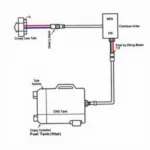Dealing with a paint scratch on your car can be frustrating. Whether it’s a minor scuff or a deep gouge, knowing How To Repair Paint Scratch On Car effectively can save you time and money. This guide provides comprehensive steps and expert advice to help you restore your car’s finish.
Learning how to repair a paint scratch on your car not only enhances its appearance but also protects it from further damage. Rust and corrosion can develop from seemingly minor scratches, impacting the structural integrity of your vehicle over time. Addressing these scratches promptly helps maintain your car’s value and prevents costly repairs down the road. See our guide on how to repair car scratches yourself for more DIY solutions.
Assessing the Damage: Types of Car Scratches
Before you begin any repair, it’s essential to assess the depth of the scratch. This will determine the appropriate repair method. Generally, car scratches are categorized into three types:
- Clear Coat Scratches: These are the most superficial, affecting only the clear coat layer. They often appear as light, hairline scratches and can sometimes be buffed out.
- Base Coat Scratches: These scratches penetrate the base coat, revealing the primer underneath. They require more than just buffing and usually involve touch-up paint.
- Deep Scratches: These reach the metal or plastic underneath the paint layers, requiring more extensive repair work to prevent rust.
How to Repair Minor Clear Coat Scratches
Minor scratches can often be addressed with DIY methods. Cleaning the area thoroughly is the first step. Use car wash soap and water, followed by a clay bar to remove any contaminants. Once dry, apply rubbing compound to the scratch using a microfiber cloth in a circular motion. This process levels the clear coat, minimizing the appearance of the scratch. Finally, apply a coat of car wax to protect the repaired area. For deeper scratches, consider how to repair car paint scratches with ease.
 Repairing a Minor Clear Coat Scratch on Car
Repairing a Minor Clear Coat Scratch on Car
How to Repair Base Coat and Deep Scratches
For scratches that penetrate the base coat or reach the metal, you may need touch-up paint. First, clean the area and sand down any protruding paint chips. Apply primer if the scratch has reached the metal. Next, carefully apply the touch-up paint in thin layers, allowing each layer to dry before applying the next. Once dry, sand the area smooth and apply clear coat. Learn more about managing deeper damage in our guide on how to repair a scuffed or damaged car bumper.
 Repairing a Base Coat Scratch with Touch-up Paint
Repairing a Base Coat Scratch with Touch-up Paint
When to Seek Professional Help
While some scratches can be handled at home, others require professional attention. Deep scratches, extensive damage, or if you’re uncomfortable with DIY methods warrant a visit to a professional auto body shop. Understanding the cost implications is crucial, which is why we’ve prepared a guide on how much cost repair scratch car. They have the expertise and tools to repair scratches seamlessly. For scratches specifically located on the car door, you can refer to our guide on how to repair scratch on car door.
Preventing Car Scratches
Preventing scratches in the first place is always the best approach. Regular washing and waxing protect your car’s paint. Parking strategically, avoiding tight spaces and areas with overhanging branches, also helps prevent scratches. Using a car cover provides an additional layer of protection against environmental elements and minor abrasions.
“Preventing scratches is always more cost-effective than repairing them,” says Maria Sanchez, Lead Auto Detailer at Pristine Auto Solutions. “Regular waxing not only adds shine but also creates a protective barrier against minor scratches.”
Conclusion
Learning how to repair paint scratch on car is a valuable skill. By understanding the type of scratch and following the correct repair procedure, you can maintain your car’s appearance and prevent further damage. However, for significant damage, professional help is recommended.
FAQ
- Can I use toothpaste to repair car scratches? While toothpaste can sometimes minimize the appearance of very superficial scratches, it’s not a long-term solution.
- What’s the difference between rubbing compound and polishing compound? Rubbing compound is more abrasive and used for deeper scratches, while polishing compound is finer and used to restore shine.
- How often should I wax my car? Waxing your car every three to four months provides adequate protection.
- Can I repair a scratch on a leased car myself? It’s best to consult your lease agreement before attempting any DIY repairs.
- What type of sandpaper should I use for wet sanding a car scratch? Start with a fine-grit sandpaper (2000-grit or higher) to avoid further damage.
- Is it necessary to apply primer before touch-up paint? Primer is essential if the scratch has reached the metal or plastic underneath the paint.
- How long does it take for touch-up paint to dry completely? Drying times vary depending on the product and environmental conditions, but it typically takes 24-48 hours.
Need further assistance? Contact us via WhatsApp: +1(641)206-8880, or Email: [email protected]. We have a 24/7 customer support team ready to assist you.


